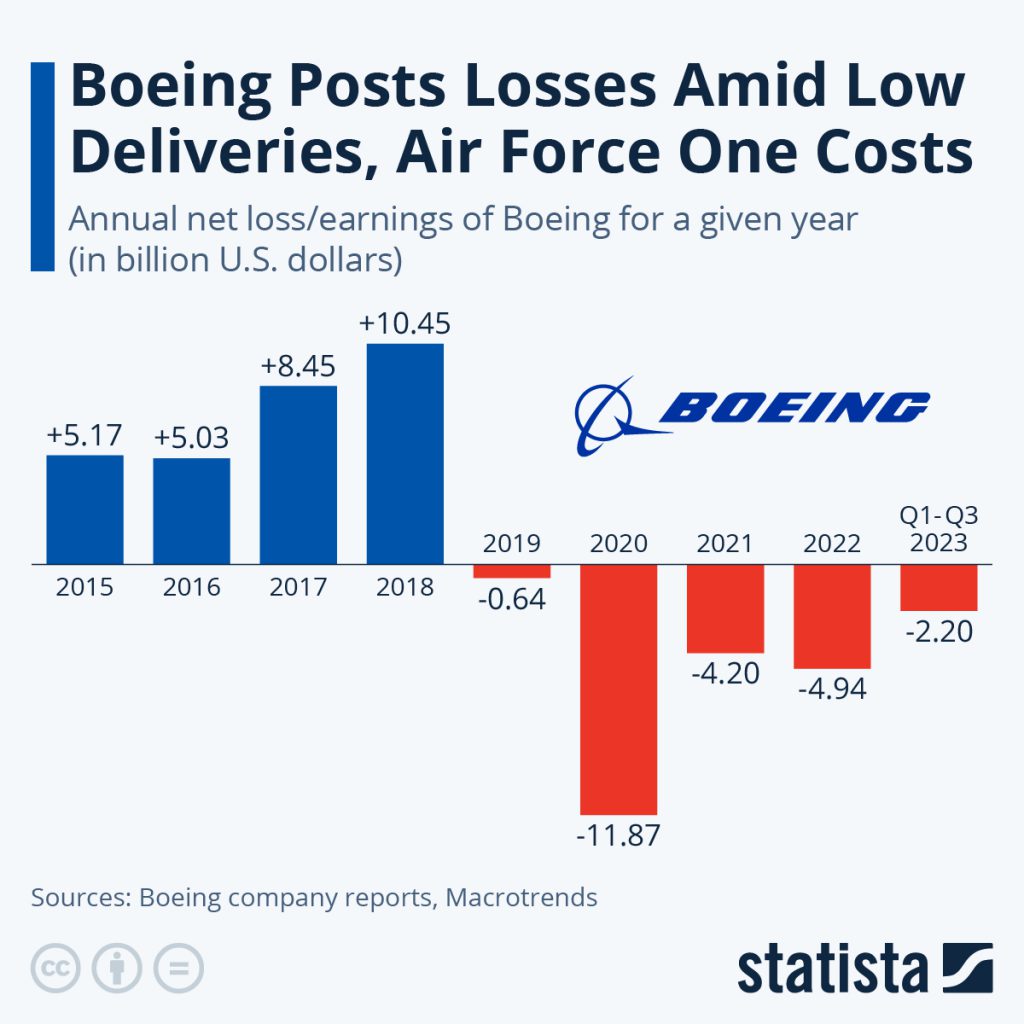From Soaring High to Stalling Out: How Boeing Lost Its Engineering Edge
The world’s largest aerospace conglomerate turns 108 this year. Boeing’s 1st plane, a Boeing Model 1 officially took off on 15 July 1916 when Wong Tsu (A Chinese graduate from MIT) completed the construction at the Heath Shipyard. As of 2023 September, a total of 78000 aircraft have rolled out of Boeing factories (excluding license-produced models elsewhere) with a total of 500+ unique aircraft designed across civilian, military, concept, prototypes and experiential designs. Boeing, really used to be a powerhouse of aviation technologies.
Boeing, once synonymous with aviation innovation, has hit turbulence in recent years. The company’s gradual decline can be traced to a shift in focus, prioritising short-term profits over the long-term commitment to hardcore engineering excellence that built its reputation.

P&L trend of Boeing, Infographics source Statista
A Legacy of Innovation Tarnished
Boeing’s history is a testament to American ingenuity. From the iconic 747 “Jumbo Jet” revolutionising passenger travel (over 1,500 delivered) to the technologically advanced 787 Dreamliner boasting superior fuel efficiency (over 1,700 delivered) [1], the company consistently pushed the boundaries of aerospace engineering. However, a gradual cultural shift began prioritising financial goals over engineering rigour. A Harvard Business Review article [2] highlights the pressure placed on engineers to meet aggressive deadlines and cost-cutting measures, potentially contributing to the tragic crashes of the 737 MAX aircraft. IMHO, The Boeing engineering disaster had roots in Welch’s deeply flawed management doctrines which were spread across American industry by his acolytes.
Lost Market Share and a Bleak Future
This shift in priorities has had significant financial consequences. The 737 MAX grounding, coupled with production delays of the 787 Dreamliner, significantly eroded Boeing’s market share. In the single-aisle passenger jet market, the crown jewel of commercial aviation, Airbus, Boeing’s main competitor, now holds a commanding lead of over 60% [3]. While Boeing struggles with a backlog of unfulfilled orders (around 4,000), Airbus boasts a healthier backlog exceeding 7,000 aircraft [4]. This translates to a stark difference in profitability. In 2023, Airbus reported a net profit of €4.2 billion ($4.5 billion) compared to Boeing’s net loss of $3.7 billion.
Examples of Lost Focus:
- 737 MAX: The faulty design and subsequent crashes of the 737 MAX (over 100 undelivered orders due to grounding) exposed a culture that prioritised speed to market over thorough engineering review.
- 787 Dreamliner: Production problems with the Dreamliner, including issues with electrical wiring and fuselage construction (hundreds of delayed deliveries), further eroded trust in Boeing’s manufacturing capabilities.
- X-32 JSF: The loss of the JSF contract to Lockheed Martin in 2001 was a major blow to Boeing, as it represented the most important international fighter aircraft project since the Lightweight Fighter program competition of the 1960s
Can Boeing Recover?
The road to recovery for Boeing will be long and arduous. Rebuilding trust with airlines and passengers will require a renewed commitment to safety and engineering excellence. This may involve significant changes in leadership and corporate culture, prioritizing long-term sustainability over short-term gains.
Boeing’s story serves as a cautionary tale for any company. While financial goals are important, sacrificing core values and engineering expertise can lead to devastating consequences. The future of this aviation giant remains uncertain, but one thing is clear: regaining its former glory will require a return to the principles that made it great in the first place.
References and Further Reading:
- [1] Boeing: Our Story https://www.boeing.com/history
- [2] Harvard Business Review: What can Corporate Boards learn from Boeing’s mistakes? – https://hbr.org/2021/06/what-corporate-boards-can-learn-from-boeings-mistakes
- [3] Leeham News and Analysis: Airbus Market Share Trends – https://leehamnews.com/2024/02/15/airbus-hails-landmark-year-with-strong-2023-results-amid-delivery-ramp-up/
- [4] Air Current: Airbus vs Boeing Order Book – https://flightplan.forecastinternational.com/2024/01/15/airbus-and-boeing-report-december-and-full-year-2023-commercial-aircraft-orders-and-deliveries/

